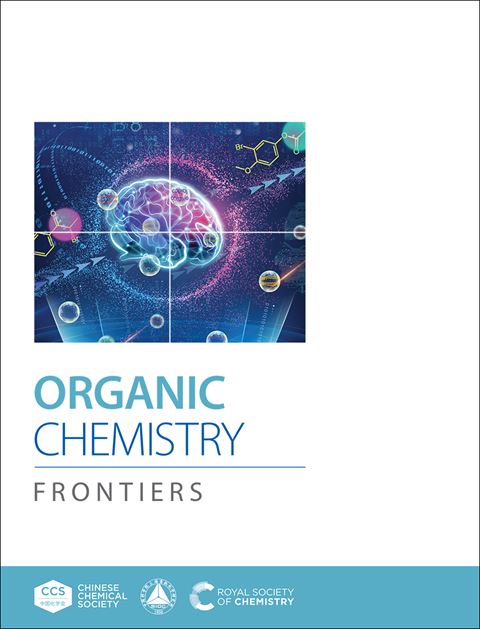铑/胺双催化在炔-环丙烯重排反应中的机理和选择性的理论见解
IF 4.7
1区 化学
Q1 CHEMISTRY, ORGANIC
引用次数: 0
摘要
铑/胺双催化作为共轭炔与环丙烯之间C-C键重建的一种有效方法,为复杂分子的合成提供了新的机会。在这项工作中,我们进行了详细的密度泛函理论(DFT)研究,以阐明完整的反应机制和选择性决定因素,这种级联转化涉及环丙烯。我们的机理研究揭示了与先前提出的实验机制的重大偏差,最值得注意的是,反应是通过合作而不是接力机制进行的,铑和胺催化剂在整个催化循环中协同作用。ETS-NOCV分析揭示了Rh₂(esp) 2配合物的双重作用:它通过促进σ-特征发展和通过金属离域来辅助胺介导的炔活化;它通过大量底物到Rh电荷转移和加强Rh -c键来稳定过渡态,在环丙烷开环和加水步骤中起关键作用。GRI和FMO分析进一步揭示二甲胺电子激活炔底物,增强其亲核性,促进更容易接近的反应途径。此外,ECDA和扭曲相互作用分析很好地解释了配体和胺依赖的产率变化,这表明富电子的Rh配体和较少空间阻碍的胺通过促进过渡态的电荷转移和最小化结构扭曲来提高催化效率。综上所述,这些发现为开发下一代选择性和高效的C-C键转化双催化系统提供了有价值的设计原则。本文章由计算机程序翻译,如有差异,请以英文原文为准。
Theoretical Insights into the Mechanism and Selectivities of Rhodium/Amine Dual Catalysis in Alkyne-Cyclopropene Reassembly Reactions
Rhodium/amine dual catalysis has recently emerged as a powerful strategy for C–C bond reconstruction between cnjugated alkynes and cyclopropenes, offering new opportunities for complex molecule synthesis. In this work, we performed detailed density functional theory (DFT) investigations to elucidate the full reaction mechanism and the selectivity-determining factors underlying this cascade transformation involving cyclopropenes. Our mechanistic study reveals significant deviations from the previously proposed experimental mechanism, most notably that the reaction proceeds via a cooperative rather than a relay-type mechanism, with rhodium and amine catalysts acting synergistically throughout the catalytic cycle. ETS-NOCV analyses uncover a dual role of the Rh₂(esp)₂ complex: it assists amine-mediated alkyne activation by promoting σ-character development and through-metal delocalization, and it plays a crucial role in the cyclopropane ring-opening and water-addition steps by stabilizing transition states through substantial substrate-to-Rh charge transfer and strengthened Rh–C bonding. GRI and FMO analyses further reveal that dimethylamine electronically activates the alkyne substrate, enhancing its nucleophilicity and facilitating a more accessible reaction pathway. In addition, ligand- and amine-dependent variations in yields are well explained by ECDA and distortion–interaction analyses, which reveal that electron-rich Rh ligands and less sterically hindered amines enhance catalytic efficiency by promoting charge transfer and minimizing structural distortion in the transition state. Taken together, these findings provide valuable design principles for developing next-generation dual catalytic systems for selective and efficient C–C bond transformations.
求助全文
通过发布文献求助,成功后即可免费获取论文全文。
去求助
来源期刊

Organic Chemistry Frontiers
CHEMISTRY, ORGANIC-
CiteScore
7.90
自引率
11.10%
发文量
686
审稿时长
1 months
期刊介绍:
Organic Chemistry Frontiers is an esteemed journal that publishes high-quality research across the field of organic chemistry. It places a significant emphasis on studies that contribute substantially to the field by introducing new or significantly improved protocols and methodologies. The journal covers a wide array of topics which include, but are not limited to, organic synthesis, the development of synthetic methodologies, catalysis, natural products, functional organic materials, supramolecular and macromolecular chemistry, as well as physical and computational organic chemistry.
 求助内容:
求助内容: 应助结果提醒方式:
应助结果提醒方式:


